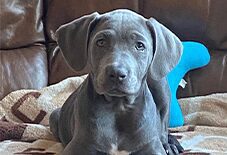Is it time for your puppy’s first bath? We’re here to help!
Whether you want to save a trip to the groomer or prefer the comfort of your own home, bathing your puppy at home is totally doable. Not only is bathing an essential part of puppy care, but it’s also a great way to bond with your pup and build trust.
Remember, every puppy is different, so some pups may feel more at ease in the bath than others. Whether your pup whines or wags at the sight of the bathtub, if you follow these tips, you can give your puppy the most positive experience possible.
Without further ado, here’s how to bathe your puppy one step at a time.
Step 1: Find puppy-safe products
As you prepare for your puppy’s bath time, you’ll want to figure out what type of dog shampoo to use based on your puppy’s coat type. If you have a young puppy, you’ll want to avoid shampoo, and bathe them only with warm water for the first few months of their life. Ask your veterinarian when they think it’s safe for you to introduce dog shampoo into your puppy’s life.
Your vet may recommend a particular puppy shampoo for your pooch’s needs. In general, it’s best to choose shampoos with natural ingredients in case your puppy has allergies. Burt’s Bees has a great oatmeal-based shampoo for pups, but whatever you choose, do not use human shampoo, as the ingredients that are safe for your hair can cause skin irritations for your dog. This applies to adult dogs, too!
Step 2: Cuddle your puppy!
First-time baths can be scary for your little one, so you want to make sure your puppy feels loved and safe. Be sure to give them lots of cuddles and maybe even a few training treats beforehand. When puppies associate baths with rewards, setting a routine becomes easier. A bad experience can cause your dog to fear bath time, making it a struggle in the future.
Step 3: Prep the bathtub
Before you introduce your puppy to the bathtub, make sure it’s prepped for the most comfortable experience possible. To prevent your dog from slipping and sliding, you may want to place a non-slip bath mat at the bottom of the tub. It’s also extremely important to make sure the water temperature is lukewarm, as water that’s too hot or too cold can shock your fur baby and give them a negative association with the tub.You may also want to invest in a dog sprayer that can attach to your shower head. Dog sprayers can make rinsing more effective and less stressful for both you and your dog.
Tip: If you have a particularly hyperactive/anxious dog, distracting them with a licking pad covered in peanut butter while you wash them can do wonders.
Pet Pro Tip: New kitten owners often underestimate the long-term costs of veterinary care for a pet’s unexpected accidents & illnesses. Make sure you get your kitten insured as soon as possible!
Step 4: Shampoo
When it’s time to introduce shampoo, make sure to avoid your dog’s ears, eyes, and mouth, so you don’t irritate your pup’s sensitive areas. It’s especially important to avoid the ears, as water can get trapped and cause ear infections. Use a soft stream of lukewarm water and move your hands in the same direction that your puppy’s hair grows. Rinse thoroughly, ensuring no shampoo is left behind.
Step 4: Condition
Much like human skin, dog skin can become dry and irritated if not properly moisturized. After a good shampoo and rinse, you should gently lather your pup in a soothing, puppy-safe conditioner. Rinse thoroughly, ensuring there’s no more product in their fur. If anything is left behind, it can cause irritation on the skin, so double check all those nooks and crannies!
Step 5: Dry off!
Do your best to towel-dry your dog as much as possible (and prepare to get sprayed as they shake off all the excess water!) Once you’ve dried them off with a towel, depending on what type of coat they have, you may need to bring in a blow dryer. You can use a small handheld hair dryer on its lowest, cool setting, or purchase a blow dryer designed specifically for dogs. Once dry, brush your dog’s hair in the direction it grows to prevent post-bath tangles, and give them lots of cuddles and treats to let them know what a good fur baby they are!
Where should you bathe your puppy?
Where you bathe your puppy will depend first and foremost on their size. A small dog can be washed in a kitchen sink, whereas a German Shepherd or Golden Retriever might need a tub of their own. You can purchase dog bathtubs, but if you have a tub or spacious shower in your bathroom, it may be easier to bathe your pooch there.
Some dog breeds, such as Poodles and Cocker Spaniels for example, will require more specialized grooming. If you’re struggling to bathe your puppy on your own, there’s no harm in bringing them to a professional. Groomers will often clip your dog’s nails and trim their hair while they’re at it – helping you take care of all of your grooming needs.
How frequently should you bathe your puppy?
How frequently your puppy will need a bath will depend on their coat, breed, and lifestyle. For example, many dogs with water-repellent coats such as Great Pyrenees will rarely need a bath, whereas dogs with oily coats such as Beagles may need a bath on a weekly basis. However, if you have a pup that loves to roll around in the mud, their messy habit will likely override these considerations altogether!
Ask your veterinarian about your puppy’s specific needs, but as a rule, bathing your pooch as frequently as once a week or as little as once a month is perfectly safe. Bathing them as little as a couple of times a year is also safe, depending on your dog’s unique needs.
By practicing good grooming habits, you can help ensure your pup is happy and healthy – which is exactly what Pumpkin puppy insurance plans aim to do. By getting your puppy pet insurance, you can help them get the best care possible, should any accidents or illnesses arise.
Don’t wait – fetch a quote today!




